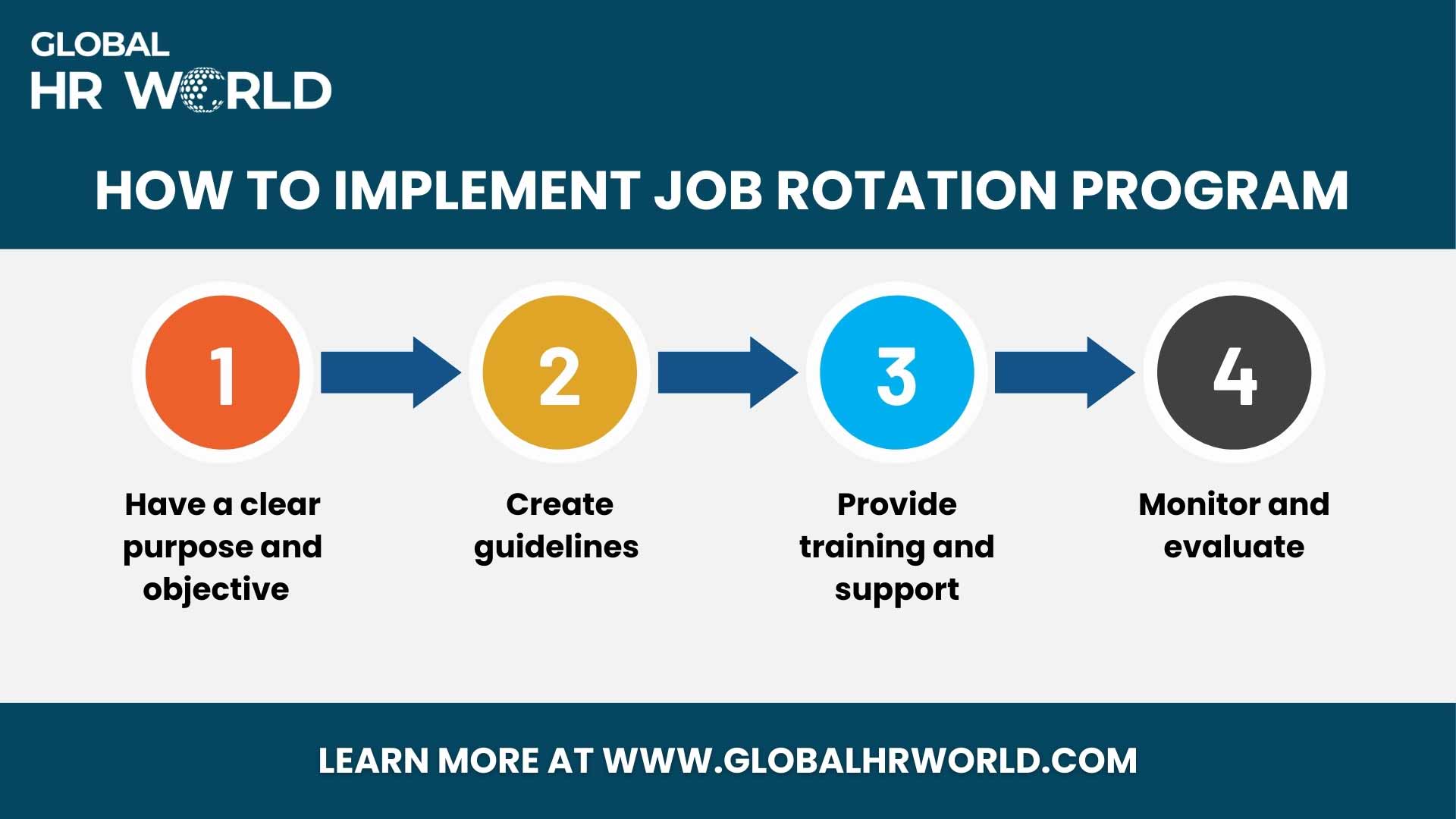Are you eager to foster a culture of continuous learning and development? Have you considered the transformative power of job rotation? From nurturing talent to promoting innovation, job rotation offers a strategic approach to unlocking potential and driving organizational success.
Here, we will talk about the benefit of job rotation for both employers and employees alike.
What is a job rotation?
Job rotation is an organizational strategy where employees rotate between different positions within the same company. Employees take on new tasks at different jobs for a period of time before rotating back to their original positions. While job rotation doesn’t necessarily equate to promotions—though they may occur—it usually involves lateral moves from one job to another. Employees enhance their skill sets and experience by embracing new tasks through this system. The primary motto of job rotation are to
- foster a flexible workforce,
- boost employee involvement, and
- improve retention rates.

Job rotation programs are company-sponsored initiatives that provide opportunities for new or existing employees to work in different roles or departments within the organization for a predetermined period of time, often ranging from a few weeks to two years. Rotation programs are typically seen as a way to boost the employee value proposition.
The benefit of job rotation
Job rotation programs offer numerous advantages for both employers and employees.

Let’s explore benefit of job rotation.
For Employers,
Benefit of job rotation 1 – Learning enhancement
Job rotation facilitates the transfer of skills, knowledge, and competencies across various roles, contributing to the accumulation of human capital. Employees understand processes comprehensively, while managers develop a well-rounded perspective crucial for senior leadership roles.
Benefit of job rotation 2 – Flexibility boost
A job rotation program increases workforce flexibility. Employees who are trained and experienced in multiple roles can easily adapt and be deployed where they are needed most. This flexibility enables smoother role transitions and enhances the capacity to fill positions efficiently.
Benefit of job rotation 3 – Employee replacement
In situations where a critical employee leaves, job rotation allows for a smoother transition by having a pool of employees who are already familiar with various roles and can step in temporarily or permanently. Job rotation also prevents stagnation and monotony, thereby reducing the likelihood of employee turnover. Offering new challenges and opportunities for growth enhances job satisfaction and lowers attrition rates.
Benefit of job rotation 4 – Orientation and placement
Rotation, commonly utilized in traineeships, allows graduates to explore diverse roles over a period, identifying their strengths and preferences. Similarly, it helps organizations match employees with roles where they can maximize their contributions, fostering optimal deployment of talent.
For Employees,
Benefit of job rotation 5 – Motivational stimulus
Regularly switching roles prevents monotony and reignites motivation by presenting new challenges and responsibilities. This dynamic environment encourages employees to adapt, learn, and stay engaged in their work.
Benefit of job rotation 6 – Continuous learning and development
Job rotation provides invaluable learning experiences for employees, particularly newcomers to the workforce. Pairing rotation with peer coaching creates opportunities for ongoing development, fulfilling employees’ thirst for knowledge and skill enhancement.
Implementing a job rotation program
Planning and implementing job rotation in your organization involves several key stages. Here is a general framework to help you through the process:

Let’s discuss.
Step 1 – Have a clear purpose and objective
When starting a new program, it is important that you define the purpose and goals of the program. And then create a structure to support that mission. The program is an opportunity for individual employees to expand their range of opportunities and visibility. With this employees can make a name for themselves within the company. As an employer, it is a chance to discover hidden gems. You may find out that some of your employees have skills and experience that you may not be aware of. Ask yourself,
- What is the point of having employees rotate jobs in your organization?
- What do you hope to accomplish with the job rotation program?
these will help you clarify the specific benefits you aim to achieve, such as skill development, talent retention, or succession planning. For example, your organizational goals may include developing employee skills, giving employees more stake in the business, and so on.
Step 2 – Create guidelines
Lay down the who, what, where, when, why, and how of your program through detailed guidelines. Like,
- Who will rotate their job?
- What is the protocol for job rotation (e.g., do employees initiate, managers, etc.)?
- Where will employees rotate?
- When will they rotate?
- How will you get employees set up in new roles?
You should consider adding guidelines to your employee rulebook so employees can reference them as required. Based on that you need to clearly define the different job roles and responsibilities within your organization. After that you must identify the knowledge, skills, and competencies required for each role and determine how they align with your objectives for job rotation. While doing so you can also consider the cross-functional, cross-departmental, or cross-level rotations that would provide valuable learning experiences for employees. Determine the duration and sequence of rotations, considering the learning objectives, skill development needs, and the employee’s career aspirations. Ensure a balance between continuity of work and exposure to new roles.
Step 3 – Provide training and support
Employers should be providing necessary training and support to employees undertaking job rotations. You need to offer them orientation programs, job shadowing opportunities, mentoring, and access to resources and job-aids that can help them transition smoothly into new roles. A few training methods for job rotation,
- Shadowing
- Mentoring
- On-the-job training
- Cross-functional training
- Job rotation workshops
- Just-in-time training
Naturally, different job roles take different amounts of time to train the employees. This implies that it is important to choose appropriate training and the corresponding length of the job rotation program.
Step 4 – Monitor and evaluate
Last but not the least, you must consider regularly assessing the program’s effectiveness. Fot that you can track the metrics involved and gathering feedback from the various stakeholders to make the necessary adjustments.
- How is the process going?
- Are there any problems in the program that need to be checked?
Once you get your job rotation up and running, determine whether it’s effective or not. Then you need to analyze the program to learn how the employees are benefiting from it.
- How is your business benefiting from it?
- Is there still any gaps to achieve the desired outcomes?
You can also consider asking your employees for feedback (e.g., short surveys) that ask for more engagement, morale, satisfaction with the job rotation, etc. Feedback can help you judge the program’s effectiveness from the employees’ perspectives.
To sum up
so with the above discussion, we can say, job rotations can have many benefits for both the employer and the employee. But again if done without a clear purpose and plan, it can lead to decreased efficiency, increased errors and confusion about job responsibilities. It is, therefore, important to clearly delineate the process of job rotation with precision to get the maximum benefit of job rotation.
Infographic

Knowledge Check!
Frequently Asked Questions (FAQs)
What is the benefit of job rotation?
Job rotation can lead to a more dynamic, skilled, and satisfied workforce, which can contribute to the overall success and adaptability of an organization.
How can organizations implement job rotation effectively?
Implementing job rotation effectively:
1. Set clear objectives: Define what the organization aims to achieve with job rotation.
2. Assess employee readiness: Not all employees may be ready or suitable for rotation. Assess their skills and readiness for new roles.
3. Provide training: Offer the necessary training to help employees succeed in their new roles.
4. Monitor and evaluate: Keep track of the program’s progress and make adjustments as needed.
Can job rotation improve employee retention?
Yes, job rotation can improve employee retention by providing employees with new challenges, opportunities to learn, and a sense of career growth within the organization.



